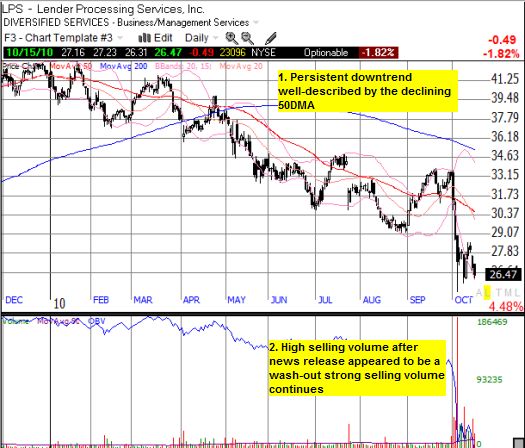Lender Processing Services (LPS) provides “…mortgage processing services, settlement services, mortgage performance analytics and default solutions.” The company claims that “a majority of the 50 largest U.S. banks” use its services. This business has put LPS right at the epicenter of “foreclosuregate.”
On September 30, immediately before the foreclosure scandal engulfed LPS, the stock experienced unusually high options activity concentrated on puts expiring in March, 2011 with a strike price of $30. 4750 puts traded versus open interest at the time of 40 puts. I was immediately intrigued because buying so many puts so far out suggests that at least one eager trader believes that a major downside catalyst is imminent but its timing is extremely uncertain.
As the news about foreclosuregate began snowballing the very next day, LPS dropped 5%. I piggybacked with a short-term trade. However, much to my surprise, the holders of these options did not close out positions the morning after the company issued a press release defending itself in the face of a decline that had reached 13%. The day after, LPS fell as much as another 11% before closing down 5%. After rallying a bit, I decided to reopen a bearish position.
LPS tried to defend itself with a press release on October 4 and a conference call the following day. LPS claimed that its services have been “mischaracterized” in the media. The company reassured investors that it “…has not executed affidavits containing substantive borrower information on behalf of its lender/servicer clients since September 2008…These affidavits were then executed by LPS consistent with industry practice, under corporate resolution. LPS had processes in place to ensure the information in the affidavits was validated and that the affidavits were signed properly.”
LPS went on to clarify that its document preparation subsidiary, Docx, LLC, generally followed proper procedures. When inappropriate procedures were discovered, the company took prompt action:
“There have also been reports in the media regarding varying signature styles on assignments of mortgage. The varying signature styles resulted from a decision made by the manager of Docx to allow an employee to sign an authorized employee’s name with his or her express written consent. LPS was unaware of this practice. As previously reported, upon learning of it, LPS immediately took remedial actions to correct all assignments of mortgage signed in this manner and provided these corrected assignments of mortgage to the two lender/servicer clients or their attorneys. LPS continues to believe this will not have a material adverse impact on its business or results of operations.” (Docx is less than 1% of LPS’s total revenue).
Barclays has also stepped up to defend LPS. On September 14, Barclays initiated an overweight rating on the stock citing valuation and the potential for a Republican victory in the November elections to create a more favorable regulatory environment for the company. After LPS issued its press release, Barclays reassured its clients that its overweight rating and $40 price target are both still justified:
“The company suggested it does not have liability associated with these issues. We have received several calls regarding LPS’ potential liability, and we believe that roughly half of the recent move in shares (down 14% over the past three trading sessions v. the S&P 500 down 1%) was related to concerns around legal implications (with the other half of the recent move related to the potential near-term, adverse impact to default services revenue from delays in the foreclosure pipeline). While we note that headlines related to foreclosure delays / legal proceedings surrounding other servicers…could cause some continued near-term volatility…we do expect yesterday’s announcement to provide some reassurance to investors.”
The market seems unconvinced by all these defenses and reassurances. Open interest on the March 2011 puts has even increased to 9627 – a doubling from September 30th’s trading volume. The trend also does not favor LPS. The stock peaked in October, 2009 and has consistently dropped via an extended downtrend for all of 2010. On Friday, LPS returned to a 15-month closing low that was set during the previous week.

*Chart created using TeleChart:

Time will soon tell whether the put-buyers have the correct outlook on the market’s likely response to the unfolding mess with foreclosures. Earnings on October 28 provide the next likely catalyst. (See Naked Capitalism’s Sept 27th article “Florida’s Kangaroo Foreclosure Courts: Judges Denying Due Process on Behalf of Banks” for one description of the poor handling of the resolution process.)
Be careful out there!
Full discloure: long LPS put

Very good observation Dr. Duru.
One other point to make is the affiliated stock FNF. If there is liablity to LPS over the Docx affiliate this will impact Fidelity Nat’l as well.
Fidelity owned DocX prior to the LPS spin off in 08. Therefore, Fidelity is part of the FL AG investigation along with LPS.
This along with the potential delay in foreclosures, escrows and title insurance all of which FNF earns its keep maybe a good long put option as well.
Lots of put option opportunities in the larger banking stock (trustees) minefield to come if the private lable MBS securitizations are forced to unwind the investors by litigation or the SEC.
PS put a 10% stop loss order below Thursdays levels across the board on all your stocks, a substantial correction maybe just around the corner.
Thanks for the additional insight!
Makes sense. I was talking to a friend yesterday about how this foreclosure mess may deliver the classic “October surprise” that helps send the market into a deep and swift correction. The weak financials continue to be a red flag for me. BAC is actually making fresh 52-week lows!